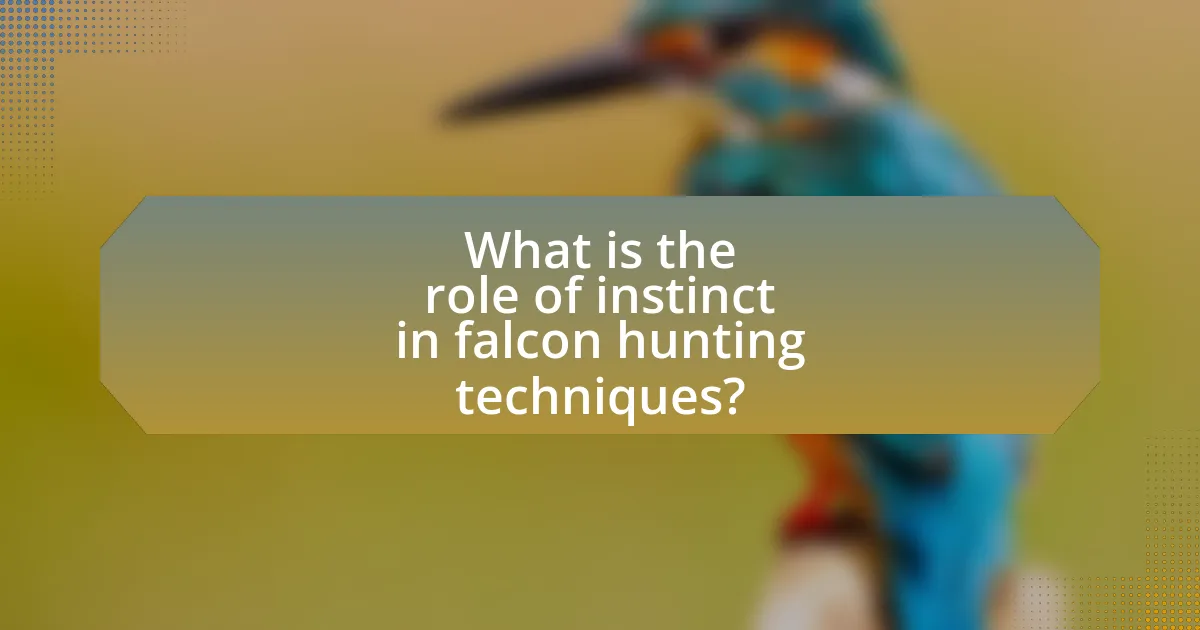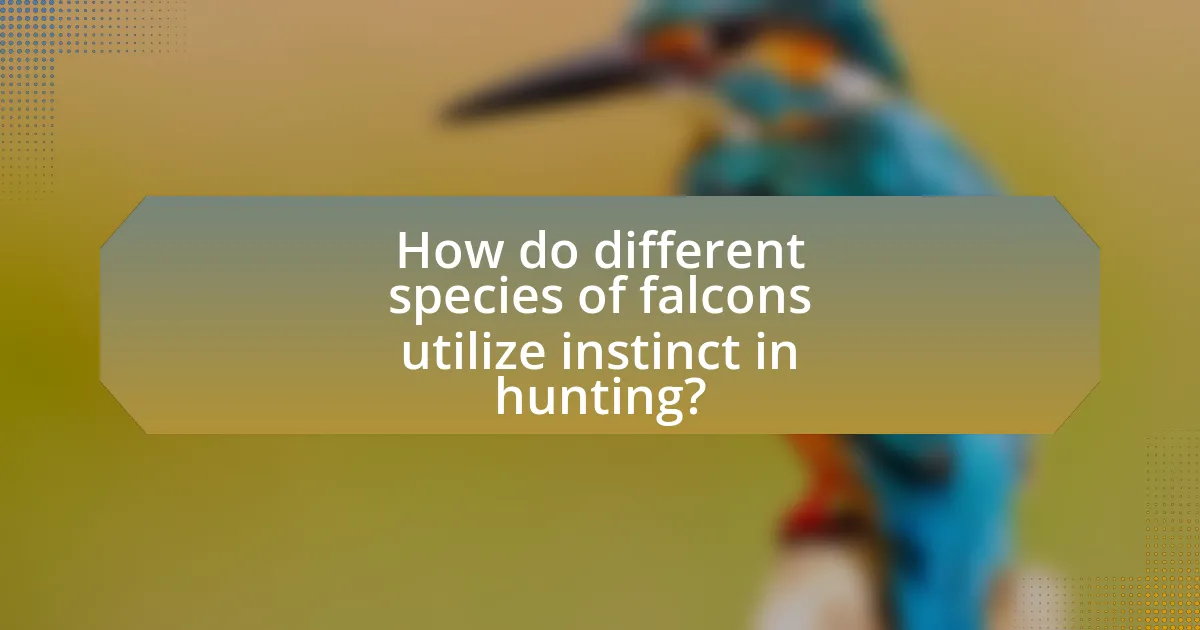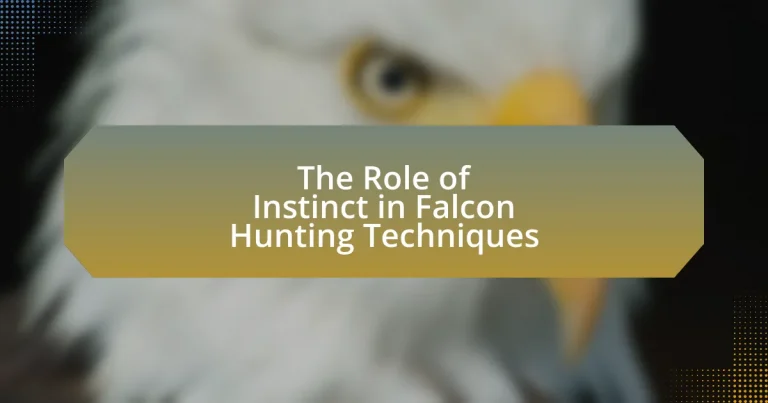The article examines the critical role of instinct in the hunting techniques of falcons, highlighting how these innate behaviors guide their actions and decision-making during hunts. It discusses the specific instincts essential for successful hunting, such as keen eyesight, precise timing, and strong predatory drive, and explains how these instincts are genetically encoded rather than learned. The article also explores the development of hunting instincts in young falcons, the influence of environmental factors on their hunting strategies, and the implications of these instinctual behaviors for falcon conservation efforts. Additionally, it addresses the variations in hunting techniques among different falcon species and the importance of understanding these instincts for effective conservation strategies.
What is the role of instinct in falcon hunting techniques?

Instinct plays a crucial role in falcon hunting techniques by guiding their behaviors and decision-making during the hunt. Falcons rely on innate instincts for critical actions such as spotting prey from great heights, executing high-speed dives, and employing specific flight patterns to capture their targets. These instinctual behaviors are honed through evolutionary adaptations that enhance their hunting efficiency, allowing them to successfully hunt small to medium-sized birds and mammals. Research indicates that these instincts are not learned but are genetically encoded, enabling falcons to perform complex hunting maneuvers without prior experience.
How do instincts influence a falcon’s hunting behavior?
Instincts significantly influence a falcon’s hunting behavior by guiding their predatory actions and decision-making processes. These innate behaviors enable falcons to efficiently locate, pursue, and capture prey, often relying on their exceptional eyesight and swift flight capabilities. For instance, the instinct to dive at high speeds allows species like the peregrine falcon to reach velocities over 240 miles per hour, making them the fastest animals on the planet. This instinctual hunting technique is crucial for successfully catching agile prey such as birds in mid-flight. Additionally, instincts dictate the falcon’s choice of hunting strategies, such as ambush or pursuit, depending on environmental factors and prey availability.
What specific instincts are crucial for successful hunting?
Successful hunting in falcons relies on specific instincts such as keen eyesight, precise timing, and strong predatory drive. These instincts enable falcons to spot prey from great distances, accurately judge the right moment to strike, and exhibit relentless pursuit. Research indicates that a falcon’s vision is adapted for detecting movement and discerning colors, which enhances their ability to locate prey effectively. Additionally, their instinctual drive to hunt is reinforced through evolutionary adaptations that prioritize survival and reproduction, making these instincts essential for their hunting success.
How do these instincts develop in young falcons?
Young falcons develop their hunting instincts primarily through a combination of genetic predisposition and experiential learning. From a young age, falcon chicks exhibit innate behaviors such as vocalizations and movements that are crucial for survival. As they grow, they observe and mimic the hunting techniques of their parents, which reinforces these instincts. Research indicates that the learning process is enhanced by the social interactions within the nest and the exposure to various stimuli in their environment, such as the presence of prey. This combination of inherited traits and learned behaviors ensures that young falcons acquire the necessary skills to hunt effectively as they mature.
Why is instinct important for falcon hunting success?
Instinct is crucial for falcon hunting success because it enables the bird to make rapid decisions and execute precise movements during the chase. Falcons possess innate behaviors that allow them to assess their environment, identify prey, and react swiftly to changes, which is essential for capturing fast-moving targets. For instance, the peregrine falcon, known for its incredible speed, relies on instinctual diving techniques to strike prey mid-air, achieving speeds over 240 miles per hour. This instinctual ability to judge distance and speed is vital for successful hunting, as it allows falcons to optimize their attack angles and timing, ensuring a higher success rate in capturing prey.
What advantages do instinctual behaviors provide during a hunt?
Instinctual behaviors provide critical advantages during a hunt by enhancing a falcon’s ability to locate, pursue, and capture prey efficiently. These innate behaviors, such as keen eyesight and rapid flight, allow falcons to detect movement from great distances and react swiftly to changes in their environment. For instance, a study published in the Journal of Avian Biology highlights that falcons can spot prey from over a mile away, demonstrating the effectiveness of their visual acuity as an instinctual trait. Additionally, instinctual behaviors like stooping—diving at high speeds—enable falcons to surprise and overwhelm their prey, increasing their hunting success rate. This combination of sensory perception and physical agility underscores the evolutionary advantages that instinctual behaviors confer during hunting activities.
How do instincts compare to learned behaviors in hunting?
Instincts in hunting are innate behaviors that are hardwired into an animal’s biology, while learned behaviors are acquired through experience and observation. For example, falcons exhibit instinctual hunting techniques such as stooping, which is a high-speed dive to catch prey, a behavior that is genetically programmed and does not require prior experience. In contrast, learned behaviors in hunting, such as specific strategies for capturing different types of prey, are developed through trial and error and social learning from other falcons. Research indicates that while instincts provide a foundational skill set for hunting, learned behaviors enhance adaptability and efficiency in various hunting scenarios, demonstrating the complementary roles of both in the hunting success of falcons.
How do different species of falcons utilize instinct in hunting?

Different species of falcons utilize instinct in hunting by employing specialized behaviors and techniques that are innate to their species. For instance, the Peregrine Falcon instinctively performs high-speed dives, known as stoops, to catch prey mid-air, demonstrating its evolved hunting strategy. Similarly, the American Kestrel uses its keen eyesight and hovering ability to spot small mammals and insects from a distance, showcasing its instinctual hunting method. These behaviors are not learned but are hardwired into their biology, allowing them to effectively hunt and capture prey in their specific environments. The effectiveness of these instinctual behaviors is supported by studies showing that falcons have evolved these techniques over millions of years, optimizing their hunting success rates.
What hunting techniques are employed by various falcon species?
Falcon species employ various hunting techniques, primarily including stooping, hovering, and ground hunting. Stooping involves high-speed dives from great heights to catch prey, which is characteristic of species like the Peregrine Falcon, known for reaching speeds over 240 mph during these dives. Hovering is utilized by species such as the Merlin, allowing them to maintain a fixed position in the air while scanning for prey. Ground hunting, seen in species like the American Kestrel, involves perching and then swooping down to capture small mammals or insects. These techniques are instinctual and have evolved to maximize hunting efficiency and success rates among different falcon species.
How does the hunting instinct vary among species?
The hunting instinct varies significantly among species due to evolutionary adaptations and ecological niches. For instance, carnivorous mammals like lions exhibit cooperative hunting strategies, which enhance their success in capturing prey, while solitary hunters like leopards rely on stealth and individual skill. Birds of prey, such as falcons, demonstrate acute vision and speed, allowing them to hunt effectively from the air. Research indicates that these instincts are shaped by factors such as habitat, prey availability, and social structures, leading to diverse hunting techniques across species.
What role does instinct play in the choice of prey?
Instinct plays a crucial role in the choice of prey for falcons, guiding their hunting behavior and decision-making processes. Falcons are instinctively programmed to recognize specific characteristics of potential prey, such as size, movement, and habitat, which influence their selection. For instance, studies have shown that peregrine falcons primarily target birds in flight, utilizing their keen eyesight and speed to identify suitable candidates. This instinctual behavior is essential for their survival, as it enhances their hunting efficiency and success rates.
How do environmental factors affect falcon instincts during hunting?
Environmental factors significantly influence falcon instincts during hunting by affecting their sensory perception and decision-making processes. For instance, variations in light conditions, such as brightness and angle of sunlight, can enhance or hinder a falcon’s ability to spot prey from great distances. Additionally, weather conditions like wind speed and direction impact a falcon’s flight patterns and hunting strategies; strong winds can aid in soaring and gliding, allowing for energy-efficient hunting. Research indicates that falcons adjust their hunting techniques based on environmental cues, demonstrating adaptability that is crucial for successful predation.
What impact does habitat have on hunting instincts?
Habitat significantly influences hunting instincts in falcons by shaping their behavior and techniques. Different environments provide varying types of prey, which in turn affects how falcons develop their hunting strategies. For instance, falcons in open habitats, such as grasslands, may rely more on speed and aerial agility to catch fast-moving prey, while those in forested areas might adapt to stealth and ambush tactics to hunt smaller, more concealed animals. Research indicates that habitat complexity directly correlates with hunting success rates, as falcons adapt their instincts to optimize for the specific challenges and opportunities presented by their surroundings.
How do seasonal changes influence hunting behaviors?
Seasonal changes significantly influence hunting behaviors in falcons by altering prey availability and environmental conditions. During spring and summer, increased daylight and warmer temperatures lead to higher activity levels in prey species, making hunting more productive for falcons. Conversely, in autumn and winter, reduced daylight and colder temperatures can decrease prey populations and alter their behavior, prompting falcons to adapt their hunting strategies, such as hunting at different times of day or targeting different prey species. Research indicates that falcons adjust their hunting techniques based on seasonal variations, demonstrating their instinctual ability to respond to environmental changes for optimal hunting success.
What are the implications of instinctual hunting techniques for falcon conservation?

Instinctual hunting techniques significantly impact falcon conservation by influencing their survival and reproductive success. These innate behaviors enable falcons to efficiently capture prey, which is crucial for their sustenance and energy requirements. Research indicates that falcons with strong instinctual hunting skills are more likely to thrive in various environments, thereby contributing to population stability. For instance, studies have shown that species like the Peregrine Falcon, which exhibit advanced hunting techniques, have rebounded from near extinction due to effective conservation efforts that support their natural behaviors. Thus, understanding and preserving these instinctual techniques is vital for ensuring the long-term viability of falcon populations.
How can understanding falcon instincts aid in conservation efforts?
Understanding falcon instincts can significantly aid in conservation efforts by informing habitat management and breeding programs. By studying the natural hunting behaviors and instincts of falcons, conservationists can identify critical habitats that support their prey species, ensuring that these environments are preserved and protected. For instance, research has shown that falcons rely on specific hunting techniques that are closely tied to their ecological niches, such as the peregrine falcon’s high-speed stoop to catch birds in flight. This knowledge allows for targeted conservation strategies that enhance the availability of prey and suitable nesting sites, ultimately supporting falcon populations.
What strategies can be implemented to protect falcon habitats?
To protect falcon habitats, implementing strategies such as habitat preservation, legal protection, and community engagement is essential. Habitat preservation involves safeguarding critical nesting and hunting areas from urban development and agricultural expansion, which can be achieved through the establishment of protected areas and wildlife reserves. Legal protection can be enforced through legislation that prohibits hunting and habitat destruction, ensuring that falcons and their environments are legally safeguarded. Community engagement fosters local stewardship, encouraging residents to participate in conservation efforts and raise awareness about the importance of falcon habitats. These strategies are supported by studies indicating that protected areas significantly enhance the survival rates of falcon populations, demonstrating the effectiveness of such measures in habitat conservation.
How does instinctual behavior inform breeding programs?
Instinctual behavior significantly informs breeding programs by guiding the selection of traits that enhance hunting efficiency and survival in falcons. Breeders analyze instinctual behaviors, such as prey recognition and hunting strategies, to identify and select individuals that exhibit superior instincts. For instance, studies have shown that falcons with strong instinctual hunting behaviors are more successful in capturing prey, which directly correlates with their reproductive success. By prioritizing these instinctual traits in breeding programs, breeders can enhance the overall performance and adaptability of falcon populations in their natural habitats.
What practical tips can enhance the understanding of falcon hunting instincts?
To enhance the understanding of falcon hunting instincts, one practical tip is to observe the falcon’s behavior in various hunting scenarios. This observation allows for the identification of specific instinctual responses, such as the falcon’s reaction to prey movement and environmental factors. Research indicates that falcons utilize keen eyesight and rapid flight to track and capture prey, demonstrating instinctual adaptations that can be studied in real-time. Additionally, engaging in falconry training can provide hands-on experience, allowing individuals to witness and interpret the instinctual behaviors exhibited by falcons during hunts. This experiential learning reinforces theoretical knowledge and deepens comprehension of their hunting instincts.
How can birdwatchers observe falcon hunting techniques effectively?
Birdwatchers can effectively observe falcon hunting techniques by utilizing binoculars or spotting scopes to maintain a safe distance while ensuring a clear view of the falcons in action. This method allows birdwatchers to witness the falcons’ aerial maneuvers, such as stooping and hovering, without disturbing their natural behavior. Additionally, birdwatchers should choose locations near known hunting grounds, such as open fields or coastal areas, where falcons are frequently seen hunting. Observing during early morning or late afternoon, when falcons are most active, increases the chances of witnessing successful hunts. Research indicates that falcons rely on instinctual behaviors, such as speed and precision, which can be observed during these peak activity times.
What resources are available for further learning about falcon instincts?
Books such as “The Falconer’s Apprentice” by John H. Smith and “Hawks in Flight” by Pete Dunne provide in-depth insights into falcon instincts. Additionally, academic journals like the Journal of Raptor Research publish studies on raptor behavior and instincts, offering empirical data and analysis. Online platforms such as the Peregrine Fund’s website also serve as valuable resources, featuring articles and videos that explore falcon instincts in detail. These resources collectively enhance understanding of the instinctual behaviors that influence falcon hunting techniques.


